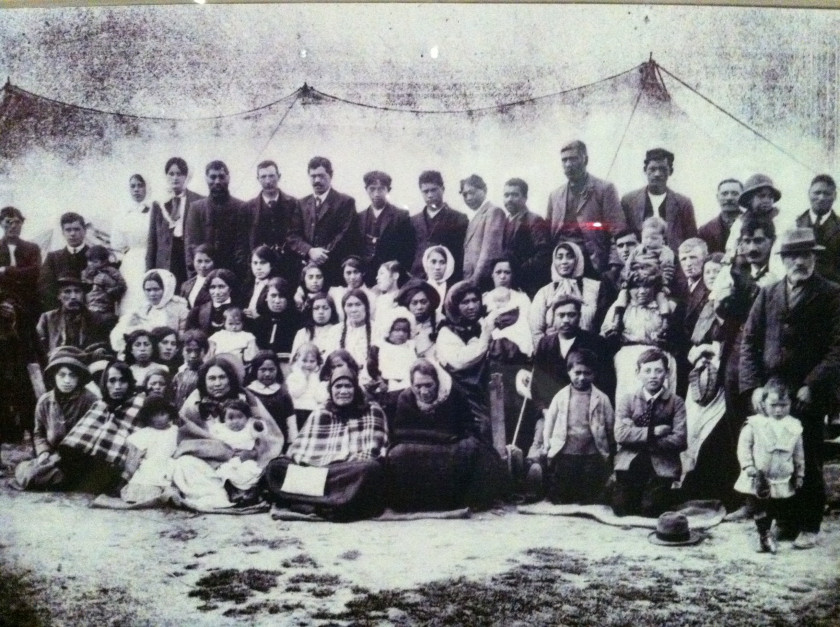A peace-full existence
Research
20 September 2021

Kelli Te Maihāroa explores a legacy of peace-making.
E whakatewhatewha ana a Kelli Te Maiharoa i te whakawhiwhika o te houhaka roko.
Te Maihāroa (?-1885) was rakatira (chief) of Waitaha iwi and the last tohuka (expert priest and healer) of Te Wai Pounamu. Waitaha followed the atua of Rongo (God of Peace), and the tikaka of rakimārie (peaceful living). In 1877 Te Maihāroa led his people on a journey up the Waitaki valley to settle at Te Ao Mārama, the world of light, known today as Ōmārama. This migration, called Te Heke, was to guard Māori from the influence of encroaching colonial settlers, and to occupy the hinterlands in an attempt to protect ancestral land through ahi-kā-roa (long burning ancestral fires of occupation). Sadly, two years later they were driven out of Ōmārama and Te Heke returned to the coast to build a new village at Korotuaheka, on the south side of near the Waitaki river.
Descendants retraced the footsteps of their tīpuna in 2012 and 2016, trekking up and down the Waitaki valley. Bronwyn Judge made a documentary of the 2016 hīkoi, which included interviews with some of the whānau. Kelli Te Maihāroa, a direct descendant of Te Maihāroa, was part of the organising committee for both walks. Kelli works for Otago Polytechnic as Tumuaki: Rakahau Māori, Director of Māori Research and Kaihautū: Te Kāhui Whetū, Leader of Capable Māori.
Kelli worked with her former colleague and friend Dr Janine Joyce to write about whānau experiences on Te Heke 2016. Using kaupapa Māori methodology for their research, Kelli and Janine Joyce independently analysed Bronwyn's film to identify the themes from this journey. They then re-examined the film jointly, to identify shared whānau experiences. The six themes are like separate, but interconnected strands of the braided Waitaki river:
- Papatūānuku | Earth Mother – it is important to nourish her mauri or spiritual life essence
- Wairua | Spirit – sharing our love and blessings with each other, the landscape, Earth Mother makes a difference
- Whakapapa | genealogy – reconnection of ancestral bloodlines, but also wider with humanity through spirit
- Whanaukataka | Relationships – ancestral links, links with other Māori prophets and passive resistance movements such as Parihaka
- Taiao | Environment - Papatūānuku doesn’t belong to us, Māori or Pākehā, spiritual connection, re-clothe her
- Mōhiotaka | Māramataka - Knowledge and Understanding
Kelli and Janine conclude that being a child of peace is about being in a state of awareness and communication with all aspects of life, which includes caring for Papatūanuku, and all physical and non-physical energies. Peace is not a movement, but a way of being.
He rakatira a Te Maihāroa (?-1885) o te iwi o Waitaha, ā, ko ia te tohuka whakamutuka o Te Wai Pounamu. I whai te iwi o Waitaha i a Rongo[TT1] me te tikaka o rakimārie. I te tau 1877, i ārahi a Te Maihāroa i ana tākata i tētahi haereka ki te kōawaawa o Waitaki ki tau ki Te Ao Mārama, ko Ōmārama i tēnei rā. I tautiaki tēnei haereka, ko Te Heke te ikoa, i te iwi Māori nā kā tākata whai Pākehā, kia noho hoki i kā tuawhenua hei whakahaumaru i te whenua mā te ahi-kā-roa. Heoi anō ko te mate, e rua kā tau i pahure, ā, i whiu rātou i Ōmārama, ā, i hoki a Te Heke ki tai kia hakaia tētahi kāika hou ki Korotuaheka, kei te taha toka e tata ana ki te awa o Waitaki.
I te tau 2012 me te tau 2016, i whai kā uri i kā tapuwae a ō rātou tīpuna, e hikoi ana i te kōawaawa o Waitaki. I hakaia e Bronwyn Judge tētahi motuheka o te hīkoi i te tau 2016, ā, i whakaurua ētahi uiui ki ētahi whānau. Ko Kelli Te Maihāroa, he uri o Te Maihāroa, tētahi o te komiti whakahaere mō kā hikoi e rua. E mahi ana a Kelli ki Te Kura Matatini ki Otago hei Tumuaki: Rakahau Māori, hei Kaihautū: Te Kāhui Whetū hoki.
I mahi tahi a Kelli rāua ko tana hoa mahi, ko Tākuta Janine Joyce kia tuhi mō kā wheako o kā whānau i Te Heke 2016. Ka mahi i te tukaka rakahau kaupapa Māori mō te rakahau, i arohaehae motuhake a Kelli rāua ko Janine Joyce i te kiriata a Bronwyn kia tautuhi i kā tāhuhu o tēnei haereka. Kātahi ka arohaehae kātahi, kia tautuhi i kā wheako o kā whānau. He pērā anō kā tāhuhu e ono ki te kāwai o te Waitaki, he motuhake, he honoka
- Ko Papatūānuku - he mea whakahirahira kia whākai i tōna mauri
- Ko te wairua - e tohatoha ana tō tātou aroha ki a tātou anō, ki te whenua, ki a Papatūānuku.
- Ko te whakapapa - ka hono anō i kā whakapapa, ekari anō ki te ao whānui mā te wairua
- Ko te whanaukataka - ko kā honoka whakapapa, ko kā honoka ki ētahi atu matakite Māori, ki ētahi atu kaupapa kairiri kūpapa, pērā i a Parihaka.
- Ko te Taiao - Ehara nō mātou, Māori mai, Pākehā mai, a Papatūānuku, he honoka ā-wairua, me whāriki anō i a ia
- Ko te mōhiotaka - te mōhiotaka me te māramataka
Ka whakatau a Kelli rāua ko Janine, kia tū hei tamaiti o te rakimārie, me whai hinekaro, me whakawhitiwhiti whakaaro ki kā āhuataka katoa o te ao, ka whakaurua te manaaki i a Papatūānuku me kā momo ā-tinana, ā-wairua hoki. Ehara te rakimārie i te kairiri, he momo oraka kē.
Links
Image credit: Te Maihāroa whānau, used with permission
Waihao whānau 1927
September 2019


